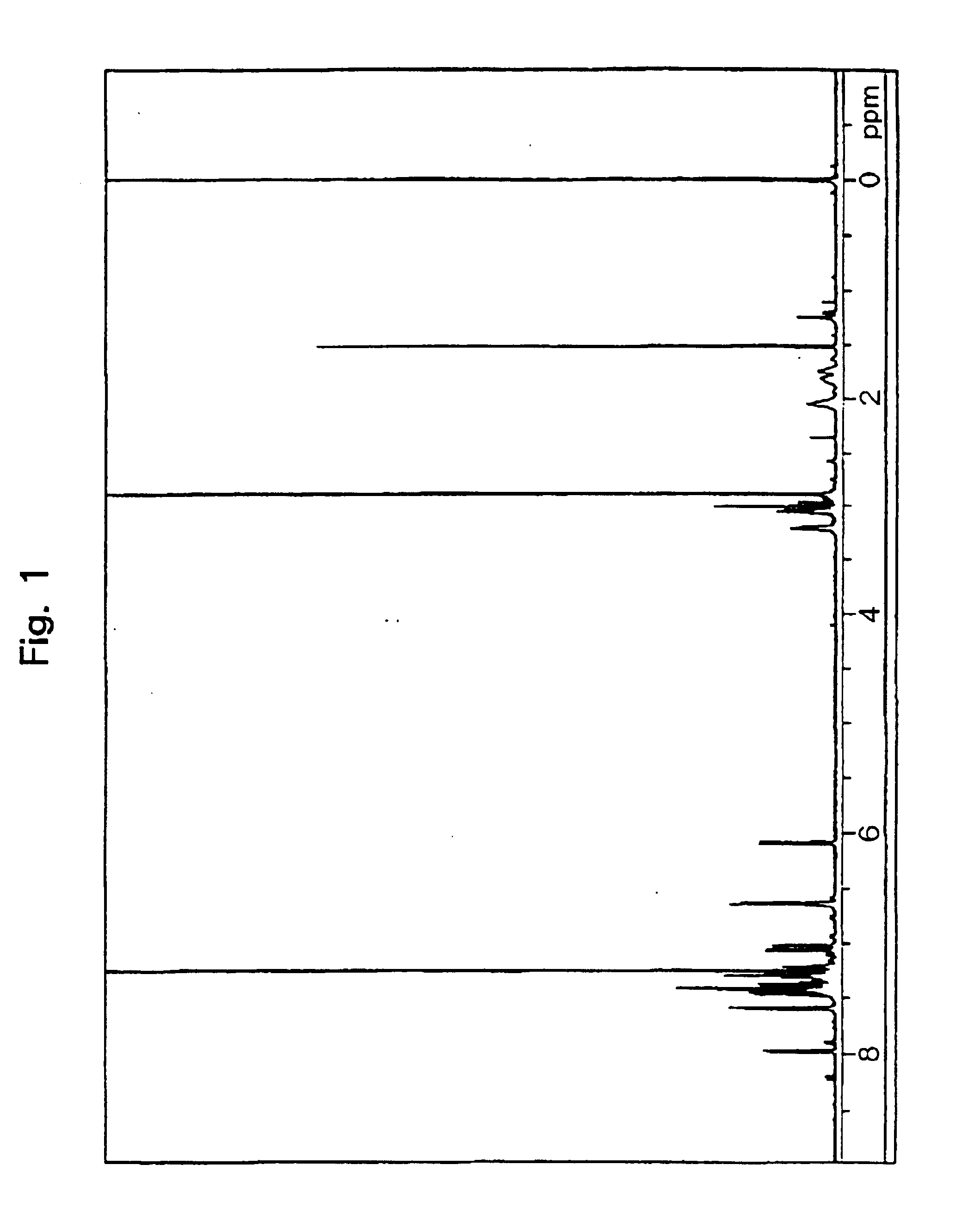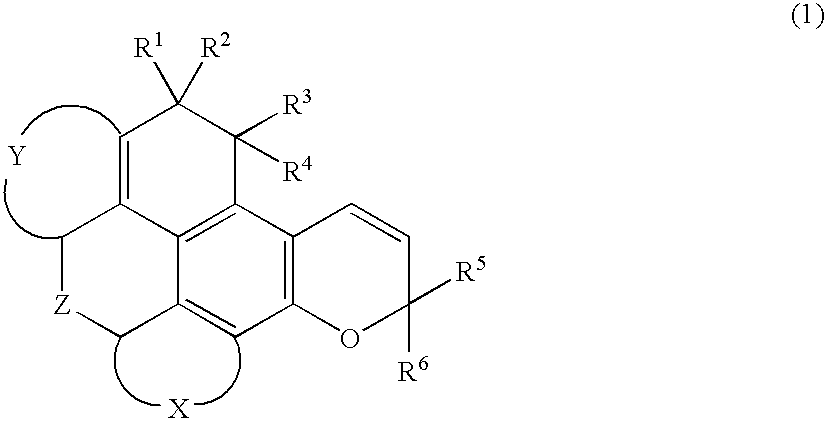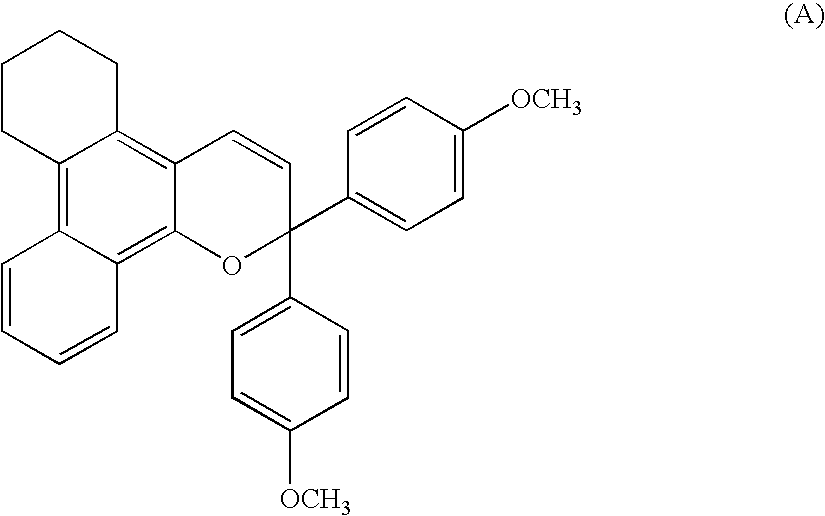Chromene compound
a compound and chromium technology, applied in the field of new compounds, can solve the problems of slow fading rate, slow fading rate, and inability to develop a color tone of neutral tint, and achieve the effects of improving the photochromic properties of conventional compounds, small initial color, and large fading ra
- Summary
- Abstract
- Description
- Claims
- Application Information
AI Technical Summary
Benefits of technology
Problems solved by technology
Method used
Image
Examples
example 1
6.3 Grams (0.02 mols) of a naphthol derivative of the following formula,
and 5.5 g (0.022 mols) of a propargyl alcohol derivative of the following formula,
were dissolved in 50 ml of toluene, followed by the addition of 0.05 g of a p-toluenesulfonic acid, and the mixture was stirred at a refluxing temperature for one hour. After the reaction, the solvent was distilled off, and the reaction product was refined by a chromatography on silica gel to obtain 3.1 g of a pale bluish powdery product, yield, 28%.
The values of elemental analysis of the product were:C: 85.44%H: 6.02%N: 2.57%O: 5.97%
which were in very good agreement with the calculated values (C: 85.53%, H: 6.07%, N: 2.56%, O: 5.84%) of C29H33NO2.
Measurement of the proton nuclear magnetic resonance spectrum indicated a peak of 16 H based on an alkylene group near δ1.0 to 4.0 ppm, and peaks of 17H based on an aromatic proton and on an alkene proton near δ5.6 to 9.0 ppm.
Further, measurement of a 13C-nuclear magnetic resonance spec...
examples 2 to 22
Chromene compounds shown in Tables 1 to 6 were synthesized in the same manner as in Example 1. The obtained products were analyzed for their structures by using the same structure confirmation means as that of Example 1 to make sure that the compounds possessed the structures represented by the structural formulas shown in Tables 1 to 6. Tables 7 and 8 show values of elemental analyses of these compounds as well as values found from the structural formulas of these compounds.
TABLE 1Starting materialEx. No.Naphthol derivativePropargyl alcohol2345Ex. No.ProductYield (%)221316433527
TABLE 2Starting materialEx. No.Naphthol derivativePropargyl alcohol6789Ex. No.ProductYield (%)626722829927
TABLE 3Starting materialEx. No.Naphthol derivativePropargyl alcohol10111213YieldEx. No.Product(%)1016111912211317
TABLE 4Starting materialEx. No.Naphthol derivativePropargyl alcohol14151617Ex. No.ProductYield (%)1422152416311719
TABLE 5Starting materialEx. No.Naphthol derivativePropargyl alcohol181920Ex. N...
applied examples
Each of the chromene compounds obtained in Examples 1 to 22 in an amount of 0.04 parts by weight, were added to 13 parts by weight of a tetraethylene glycol dimethacrylate, 48 parts by weight of a 2,2-bis[4-(methacryloxyethoxy)phenyl]propane, 2 parts by weight of a polyethylene glycol monoallyl ether, 20 parts by weight of a trimethylolpropane trimethacrylate, and 9 parts by weight of a glycidyl methacrylate, and to which was further added, as a polymerization initiator, 1 part by weight of a t-butylperoxy 2-ethyl hexanate, and the mixture was mixed together to a sufficient degree.
The mixture was poured into a mold constituted by glass plates and a gasket of an ethylene / vinyl acetate copolymer, and was cast-polymerized. The polymerization was conducted by using an air furnace while gradually raising the temperature from 30° C. to 90° C. over 18 hours, and the temperature of 90° C. was maintained for 2 hours. After the polymerization, the polymer was taken out from the glass mold.
The...
PUM
| Property | Measurement | Unit |
|---|---|---|
| photochromic | aaaaa | aaaaa |
| photochromic properties | aaaaa | aaaaa |
| resistance | aaaaa | aaaaa |
Abstract
Description
Claims
Application Information
 Login to View More
Login to View More - R&D
- Intellectual Property
- Life Sciences
- Materials
- Tech Scout
- Unparalleled Data Quality
- Higher Quality Content
- 60% Fewer Hallucinations
Browse by: Latest US Patents, China's latest patents, Technical Efficacy Thesaurus, Application Domain, Technology Topic, Popular Technical Reports.
© 2025 PatSnap. All rights reserved.Legal|Privacy policy|Modern Slavery Act Transparency Statement|Sitemap|About US| Contact US: help@patsnap.com



